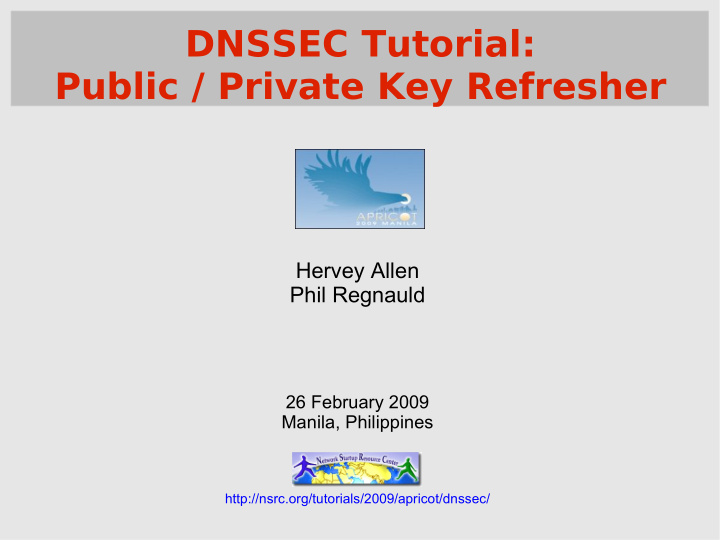



DNSSEC Tutorial: Public / Private Key Refresher Hervey Allen Phil Regnauld 26 February 2009 Manila, Philippines http://nsrc.org/tutorials/2009/apricot/dnssec/
Public-Private Keys Refresher Ciphers Ciphertext Symmetric Cipher / Private Key Public Key Hashing functions Hash / message digest Digital Signatures Why rsa vs. dsa, sha-1 or sha-256 vs. md5?
Ciphers ==> ciphertext We start with plaintext . Something you can read. We apply a mathematical algorithm to the plaintext . The algorithm is the cipher . The plaintext is turned in to ciphertext . Almost all ciphers were secret until recently. Creating a secure cipher is HARD .
Keys To create ciphertext and turn it back to plaintext we apply a key to the cipher . The security of the ciphertext rests with the key . This is a critical point. If someone obtains your key , your data is compromised. This type of key is called a private key . This type of cipher system is efficient for large amounts of data. This is a symmetric cipher .
Symmetric Cipher Private Key/Symmetric Ciphers cipher text clear clear text text K K The same key is used to encrypt the document before sending and to decrypt it once it is received
Features of Symmetric Ciphers ● Fast to encrypt and decrypt, suitable for large volumes of data. ● A well-designed cipher is only subject to brute-force attack; the strength is therefore directly related to the key length. ● Current recommendation is a key length of at least 90 bits. Symmetric Ciphers in use exceed this length: ● 3DES = 112 bits, Blowfish = 128 bits, etc. ● Problem - how do you distribute the keys?
Public / Private Keys We generate a cipher key pair. One key is the private key , the other is the public key . The private key remains secret and should be protected. The public key is freely distributable. It is related mathematically to the private key, but you cannot (easily) reverse engineer the private key from the public key. Use the public key to encrypt data. Only someone with the private key can decrypt the encrypted data.
Example Public / Private Key Pair cipher text clear k 1 k 2 text ( public key ) ( private key ) One key is used to encrypt the document, a different key is used to decrypt it. This is a big deal!
Issues Symmetric ciphers (one private key) are much more efficient. About 1000x more efficient than public key algorithms for data transmission! Attack on the public key is possible via chosen- plaintext attack. Thus, the public/private key pair need to be large (2048 bits). For larger data transmissions than used in DNSSEC we use hybrid systems . That's another discussion.
One-Way Hashing Functions A mathematical function that generates a fixed length result regardless of the amount of data you pass through it. Generally very fast. You cannot generate the original data from the fixed-length result. Hopefully you cannot find two sets of data that produce the same fixed-length result. If you do this is called a collision .
One-Way Hashing Functions cont. Some popular hashing functions include: − md5 : Outputs 128 bit result. Fast. Collisions found. − sha-1 : Outputs 160 bits. Slower. Collisions in 2 x69 . − sha-2 : Outputs 224-512 bits. Slower. Collisions expected (2 x80 attack). − sha-3 : TBA: Currently in development via a new NIST Hash Function Competition. Applying a hashing function to plaintext is called munging the document . The fixed-length result is referred to as a checksum, fingerprint, message digest, etc.
Hashing One-Way Encryption Fixed length hash hashing or message digest clear function text Munging the document gives a short message digest (checksum). Not possible to go back from the digest to the original document.
Hashing another example Note the significant change in the hash sum for minor changes in the input. Note that the hash sum is the same length for varying input sizes. This is extremely useful. *Image courtesy Wikipedia.org.
What use is this? ● You can run many megabytes of data through a hashing function, but only have to check a fixed number of bits of information (160-512 bits). A compact and unique document signature .* ● You can generate a passphrase for your data – such as your encrypted private key. If someone gets your private key, they still must know your passphrase to decrypt anything using your private key.
Protecting the Private Key symmetric k 2 cipher k 2 (encrypted ready on disk) for use key Passphrase entered by user hash K 2 = private *Such as SHA-1,SHA-2 etc. key
Checking passphrases/passwords Q.) How do you do this? A.) It's very simple. − Type in a passphrase/password. − Run the hashing function on the text. − If the message digest matches, you typed in the correct passphrase/password.
Digital Signatures Let's reverse the role of public and private keys. To create a digital signature on a document do: − Munge a document. − Encrypt the message digest with your private key. − Send the document plus the encrypted message digest. − On the other end munge the document and decrypt the encrypted message digest with the person's public key. − If they match, the document is authenticated.
When Authenticating: Take a hash of the document and encrypt only that. An encrypted hash is called a " digital signature " hash hash digital COMPARE signature k 2 k 1 (private) (public)
Our Original Question Revisited Let's answer our original question... Why rsa vs. dsa, sha-1 or sha-256 vs. md5? rsa can do 2048 bits and greater dsa max bits is 1024 md5 has collisions sha-1 / sha-2 collisions expected, but more secure for the moment.
Conclusion Public / Private keys Message digests Digital signatures Are at the core of DNSSEC. If these do not make sense, then DNSSEC will not make sense.
Recommend
More recommend